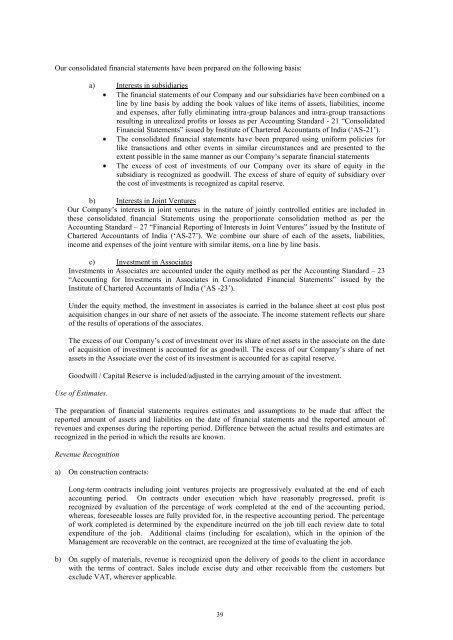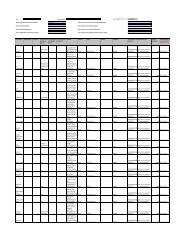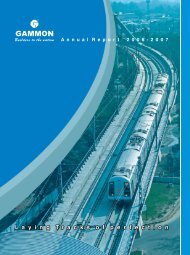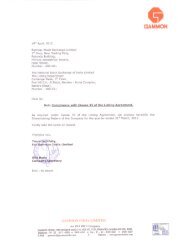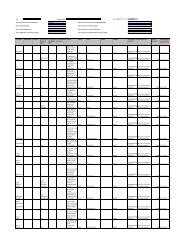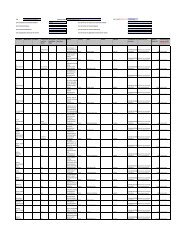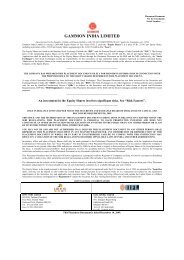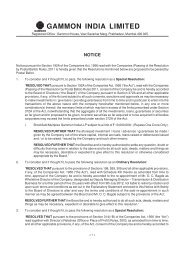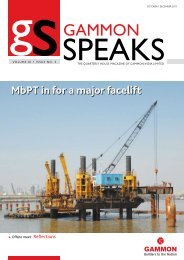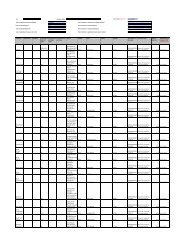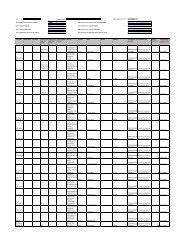GAMMON INDIA LIMITED
GAMMON INDIA LIMITED
GAMMON INDIA LIMITED
Create successful ePaper yourself
Turn your PDF publications into a flip-book with our unique Google optimized e-Paper software.
Our consolidated financial statements have been prepared on the following basis:<br />
a) Interests in subsidiaries<br />
The financial statements of our Company and our subsidiaries have been combined on a<br />
line by line basis by adding the book values of like items of assets, liabilities, income<br />
and expenses, after fully eliminating intra-group balances and intra-group transactions<br />
resulting in unrealized profits or losses as per Accounting Standard - 21 ―Consolidated<br />
Financial Statements‖ issued by Institute of Chartered Accountants of India (‗AS-21‘).<br />
The consolidated financial statements have been prepared using uniform policies for<br />
like transactions and other events in similar circumstances and are presented to the<br />
extent possible in the same manner as our Company‘s separate financial statements<br />
The excess of cost of investments of our Company over its share of equity in the<br />
subsidiary is recognized as goodwill. The excess of share of equity of subsidiary over<br />
the cost of investments is recognized as capital reserve.<br />
b) Interests in Joint Ventures<br />
Our Company‘s interests in joint ventures in the nature of jointly controlled entities are included in<br />
these consolidated financial Statements using the proportionate consolidation method as per the<br />
Accounting Standard – 27 ―Financial Reporting of Interests in Joint Ventures‖ issued by the Institute of<br />
Chartered Accountants of India (‗AS-27‘). We combine our share of each of the assets, liabilities,<br />
income and expenses of the joint venture with similar items, on a line by line basis.<br />
c) Investment in Associates<br />
Investments in Associates are accounted under the equity method as per the Accounting Standard – 23<br />
―Accounting for Investments in Associates in Consolidated Financial Statements‖ issued by the<br />
Institute of Chartered Accountants of India (‗AS -23‘).<br />
Under the equity method, the investment in associates is carried in the balance sheet at cost plus post<br />
acquisition changes in our share of net assets of the associate. The income statement reflects our share<br />
of the results of operations of the associates.<br />
The excess of our Company‘s cost of investment over its share of net assets in the associate on the date<br />
of acquisition of investment is accounted for as goodwill. The excess of our Company‘s share of net<br />
assets in the Associate over the cost of its investment is accounted for as capital reserve.<br />
Goodwill / Capital Reserve is included/adjusted in the carrying amount of the investment.<br />
Use of Estimates.<br />
The preparation of financial statements requires estimates and assumptions to be made that affect the<br />
reported amount of assets and liabilities on the date of financial statements and the reported amount of<br />
revenues and expenses during the reporting period. Difference between the actual results and estimates are<br />
recognized in the period in which the results are known.<br />
Revenue Recognition<br />
a) On construction contracts:<br />
Long-term contracts including joint ventures projects are progressively evaluated at the end of each<br />
accounting period. On contracts under execution which have reasonably progressed, profit is<br />
recognized by evaluation of the percentage of work completed at the end of the accounting period,<br />
whereas, foreseeable losses are fully provided for, in the respective accounting period. The percentage<br />
of work completed is determined by the expenditure incurred on the job till each review date to total<br />
expenditure of the job. Additional claims (including for escalation), which in the opinion of the<br />
Management are recoverable on the contract, are recognized at the time of evaluating the job.<br />
b) On supply of materials, revenue is recognized upon the delivery of goods to the client in accordance<br />
with the terms of contract. Sales include excise duty and other receivable from the customers but<br />
exclude VAT, wherever applicable.<br />
39


